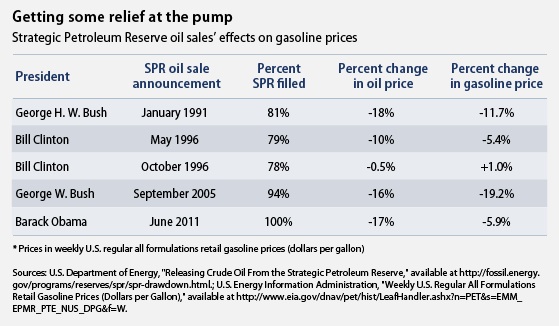Time to Tap the Strategic Oil Reserves?
 President Obama should use the strategic petroleum reserve to lower gasoline prices
President Obama should use the strategic petroleum reserve to lower gasoline pricesAmericans are rightly concerned about rising oil and gasoline prices. On February 21 oil closed at $106 per barrel, while the average gallon of gas in the United States cost $3.59. Bloomberg reports that prices could continue to rise:
While gas prices tend to rise through the first half of the year, this is the earliest the average price per gallon has breached the $3.50 mark. If this pace continues, the national average should hit $4 a gallon by May, if not sooner.
This is not good news for consumers or for the economy. High oil and gasoline prices slow economic growth and take a real toll on families’ already-strained budgets. They are difficult to lower in the short run because it is very hard to promptly increase oil supplies. Meanwhile, demand for gasoline does not decrease even as prices increase because most people cannot quickly and significantly reduce the amount they drive.
There is one proven tool for temporary reductions in oil and gasoline prices that can forestall reduced economic growth and help middle-class families: selling oil reserves from the Strategic Petroleum Reserve.

President Barack Obama plans to speak about high oil and gasoline prices today in Florida. He will remind Americans that oil production is up and consumption is down, which means that families are saving money on fewer gasoline purchases even though prices are rising. The payroll tax cut extension will provide an average of $40 more per paycheck and will also help ease some of the strain of higher gasoline prices. It is unlikely the president will announce the sale of reserve oil during the speech, but it remains an option if prices continue to climb.
Why are oil and gasoline prices so high?
Oil and gasoline prices are rising now for a myriad of reasons. Growing demand from China and India has boosted consumption, and Libyan production has yet to return to its prewar level of 1.6 million barrels per day. Pat Garofalo of ThinkProgress reports that the price is going up “despite lowest [U.S.] demand [for oil] since 1997.” He cites Tom Kloza, chief oil analyst for the Oil Price Information Service, who says that speculators are helping to drive up oil prices:
Much of the increase is due to speculative money that’s flowed into gasoline futures contracts since the beginning of the year, mostly from hedge funds and large money managers. “We’ve seen about $11 billion of speculative money come in on the long side of gas futures,” [Kloza] says. “Each of the last three weeks we’ve seen a record net-long position being taken.”
Another major source of high prices is Iran’s threat to cut off oil exports to Western nations that are pressuring it to abandon its nuclear weapons program. On February 19, for instance, Iran announced that it would stop sales to England and France. Although these two nations buy very little Iranian oil, fear that Iran would stop supplying other, more dependent countries boosted the spot price for oil by $3 per barrel overnight. This was also partly driven by speculators taking advantage of fears about future production cuts. And since the price of oil accounts for nearly 80 percent of the price of a gallon of gas, this cost jump will boost gasoline prices too.
What can we do about high oil and gasoline prices?
There are very few policy measures that can rapidly reduce oil and gasoline prices, but selling oil from the Strategic Petroleum Reserve to oil companies can help. The reserve was created in 1975 as a hedge against serious oil supply disruptions such as the Arab oil embargo of 1973–1974. It has a capacity of 727 million barrels of oil and is currently 96 percent full with 696 million barrels.
Presidents have the authority to sell reserve oil under the following circumstances described in the Energy Policy and Conservation Act:
Drawdown and sale of petroleum products from the Strategic Petroleum Reserve may not be made unless the President has found drawdown and sale are required by a severe energy supply interruption or by obligations of the United States under the international energy program.
(2) For purposes of this section, in addition to the circumstances set forth in section 3 (8), a severe energy supply interruption shall be deemed to exist if the President determines that -
(A) an emergency situation exists and there is a significant reduction in supply which is of significant scope and duration;
(B) a severe increase in the price of petroleum products has resulted from such emergency situation; and
(C) such price increase is likely to cause a major adverse impact on the national economy.
There have been reserve oil sales under every president since 1991.
*President George H. W. Bush sold reserve oil before the first Iraq war in anticipation of supply disruptions that did not materialize.
*The Republican Congress required two sales of reserve oil in 1996 to reduce the federal budget deficit.
*President George W. Bush sold oil in 2005 after Hurricanes Katrina and Rita disrupted production in the Gulf of Mexico.
*Last year President Barack Obama sold 30 million barrels of reserve oil to offset the disruption of Libyan oil production during its civil war. Our partners in International Energy Agency, or IEA, nations sold 30 million barrels of their reserve oil, as well. (The IEA is an intergovernmental organization dedicated to responding to physical disruptions in the supply of oil, as well as serving as an information source on statistics about the international oil market and other energy sectors.)
Reserve oil sales reduce oil and gasoline prices.For instance, last year the administration announced its sale of SPR oil on June 23 with completion on September 30. The IEA sale occurred during this time too. From the time of the announcement to the time of final sale, the price of West Texas Intermediate crude oil dropped by 17 percent, while the price of gasoline fell by 6 percent. Such a decline would reduce $4 per gallon gasoline to $3.76 per gallon.
There is also a legitimate concern about adequate oil reserves in case of a severe Iranian supply disruption, but we have ample supplies in the SPR to withstand it. Iran exports 2.2 million barrels of oil per day worldwide, and none of it comes to the United States. The United States could replace these Iranian exports to other nations for 60 days, and our reserves would still be 80 percent full. And after completely offsetting a 180-day disruption in Iranian oil supplies, the SPR would still be 40 percent full.
Iran has also threatened to cut off the Strait of Hormuz through which 17 million barrels of oil travel every day. This is about one-fifth of worldwide consumption. There is enough oil in the SPR that the United States could replace this oil for three weeks, and its reserves would still be half full. The bigger challenge in that scenario is that the SPR can release no more than 4.4 million barrels per day.
Obama adopted long-term measures to reduce oil and gasoline costs
President Obama has overseen a growth in oil supply and a reduction in demand—both of which can reduce prices. Since 2009 there has been a significant increase in U.S. oil production. It now produces a majority of its oil for the first time in 15 years. The Houston Chronicle reports that:
The number of rigs in U.S. oil fields has more than quadrupled in the past three years to 1,272… Including those in natural gas fields, the United States now has more rigs at work than the entire rest of the world.
This domestic production improved our energy security and reduced the amount of money we send overseas for foreign oil. But the aforementioned factors have kept prices high.
As significantly, the president modernized fuel-efficiency standards for vehicles for the first time in more than two decades. By 2025 cars and light trucks will go twice as far on a gallon of gas and will save more than 2 million barrels of oil per day. The improved standards will also save drivers $8,200 in lower gasoline purchases over the life of their vehicle compared to 2010 standards.
High gasoline prices impose real costs on middle- and low-income Americans. President Obama’s plans to increase oil production while improving fuel economy for vehicles will provide real relief. For immediate relief from high gasoline expenses, however, history shows that selling a small amount of oil from the Strategic Petroleum Reserve will lower prices.
You can return to the main Market News page, or press the Back button on your browser.

